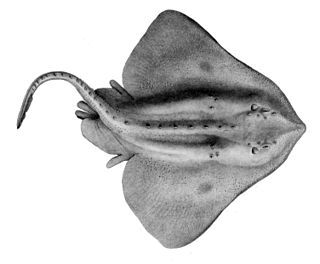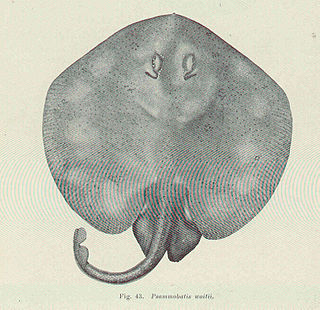
The wagtail is a genus, Motacilla, of passerine birds in the family Motacillidae. The forest wagtail belongs to the monotypic genus Dendronanthus which is closely related to Motacilla and sometimes included therein. The common name and genus names are derived from their characteristic tail pumping behaviour. Together with the pipits and longclaws they form the family Motacillidae.

Skates are cartilaginous fish belonging to the family Rajidae in the superorder Batoidea of rays. More than 150 species have been described, in 17 genera. Softnose skates and pygmy skates were previously treated as subfamilies of Rajidae, but are now considered as distinct families. Alternatively, the name "skate" is used to refer to the entire order of Rajiformes.

The red-bellied black snake is a species of venomous snake in the family Elapidae. The species is indigenous to Australia. Originally described by George Shaw in 1794 as a species new to science, it is one of eastern Australia's most commonly encountered snakes. Averaging around 1.25 m in length, it has glossy black upperparts, bright red or orange flanks, and a pink or dull red belly. It is not an aggressive species and generally retreats from encounters with people, but can attack if provoked. Although its venom is capable of causing significant illness, no deaths have been recorded from its bite, which is less venomous than other Australian elapid snakes. The venom contains neurotoxins, myotoxins, and coagulants and has haemolytic properties; victims can also lose their sense of smell.
Skate or Skates may refer to:

Bathyraja is a large genus of skates in the family Arhynchobatidae.

Dipturus is a large genus of skates native to the Pacific, Atlantic, and Indian Oceans. They were formerly included in Raja. Some species initially moved to Dipturus were later placed in Dentiraja, Spiniraja, and Zearaja.
Notoraja is a genus of skates in the family Arhynchobatidae. They are found in deep water in the Indian and western Pacific Ocean.

The yellow-bellied bulbul is a species of songbird in the bulbul family, Pycnonotidae. It is found on the Malay Peninsula, Sumatra and Borneo. Its natural habitat is subtropical or tropical moist lowland forests.
Bathyraja maculata, the white-blotched skate, is a species of skate from the western North Pacific Ocean. An adult is approximately 1 meter in length, and is found at depths of up to 1 kilometer. Unlike any other known member of the genus Bathyraja, the white-blotched skate has white blotches on a grey to brown dorsal surface, while the ventral side is lighter in color with darker blotches. Dorsal side is rough with spines, while the ventral side is smooth.

Arhynchobatidae is a family of skates and is commonly known as the softnose skates. It belongs to the order Rajiformes in the superorder Batoidea of rays. At least 104 species have been described, in 13 genera. Softnose skates have at times been placed in the same family as hardnose skates, but most recent authors recognize them as a distinct family. Members of the Arhynchobatidae can be distinguished from hardnose skates in having a soft and flexible snout, as well as a more or less reduced rostrum.

Irolita is a genus of softnose skates in the family Arhynchobatidae, commonly known as round skates. There are two species, both endemic to Australia, found over soft bottoms on the outer continental shelves and upper continental slopes, at depths of 50–200 m for the southern round skate and 142–209 m for the western round skate. The distributions of the two species do not overlap.

Bathyraja mariposa, sometimes referred to as the butterfly skate, is a species of skate found in the Aleutian islands. It is overall a medium-brown color, lacks thorns on the disc and has indistinct thorns on the tail. It was discovered in 2002 during a National Marine Fisheries Service survey, and first described in 2004. The holotype specimen is held at the University of Washington. Its species name "mariposa" derives from the Spanish word for butterfly, although several other species are sometimes referred to as the "butterfly skate."
The white-dotted skate is a species of skate in the family Arhynchobatidae. It is found in the south-western Atlantic off the coast of Uruguay, Argentina and the Falkland Islands and uncommonly off Chile in the south-eastern Pacific Ocean, at depths ranging from 55 to 861 metres. Males reach maturity at the age of about 11 years and females about 10 years. At maturity the total length of males is about 62.8 cm and females 65.3 cm. The oldest reported specimen was 17 years old. The maximum length has been estimated to be almost one metre. It is oviparous. Egg capsules are oblong having horned corners, the horns at the back end appear first and are longer, and thinner than the front ones. Capsules are barrel-shaped, quite smooth, yellow-brown when freshly laid, but they get darker. Egg laying has been observed year-round, but most frequently in autumn and winter. The animal eats mainly benthopelagic gammarids and polychaetes and also isopods. Juvenile white-dotted skates eat mostly gammarid amphipods, while adults eat mostly polychaetes.

The mottled skate is a species of skate in the family Rajidae. An inhabitant of shallow coastal waters, it is found in the northwestern Pacific Ocean off Korea, Japan, and China. This species grows to 1.12 m (3.7 ft) long and has a diamond-shaped pectoral fin disc with a long snout. It is characterized by a covering of prickles above and below its snout, but not elsewhere on its body, and a dark ring in the middle of each "wing".
Brochiraja is a genus of deep-sea skates in the family Arhynchobatidae containing eight species. They are found in the waters around New Zealand and the Tasman Sea.

Okamejei is a genus of small skates in the family Rajidae from the central and western Indo-Pacific, and the north-western Pacific Ocean.
Bathyraja leucomelanos, commonly known as domino skate, is a species of softnose skate, closely related to Bathyraja spinicauda. The complete range is not known, however the holotype specimen of B. leucomelanos was caught on the Coriolis Bank, off western New Caledonia in 2002. The male holotype specimen measures 888 millimetres (35 in) total length and 608 mm (24 in) across the disc. Dorsal coloration is mostly white, with black on the disc and tail margins. Ventral coloration is black.
The longnose deep-sea skate is a large skate in the family Arhynchobatidae. It was first described in 1985 from specimens collected near New Zealand. It is known to be a deep-water skate, however lack of research trawls at depths past 1500 meters limits knowledge of the depths where the species can be found. The species is dark brown or grey, with an eponymous elongated snout. The species has been measured to be a maximum of 140 cm in total length, although size variation and growth patterns are not known.
Bathyraja maccaini, also known as McCain's skate, is a species of softnose skate in the family Arhynchobatidae. It is found in Antarctic and Subantarctic waters at depths of between 167 and 500 metres.









